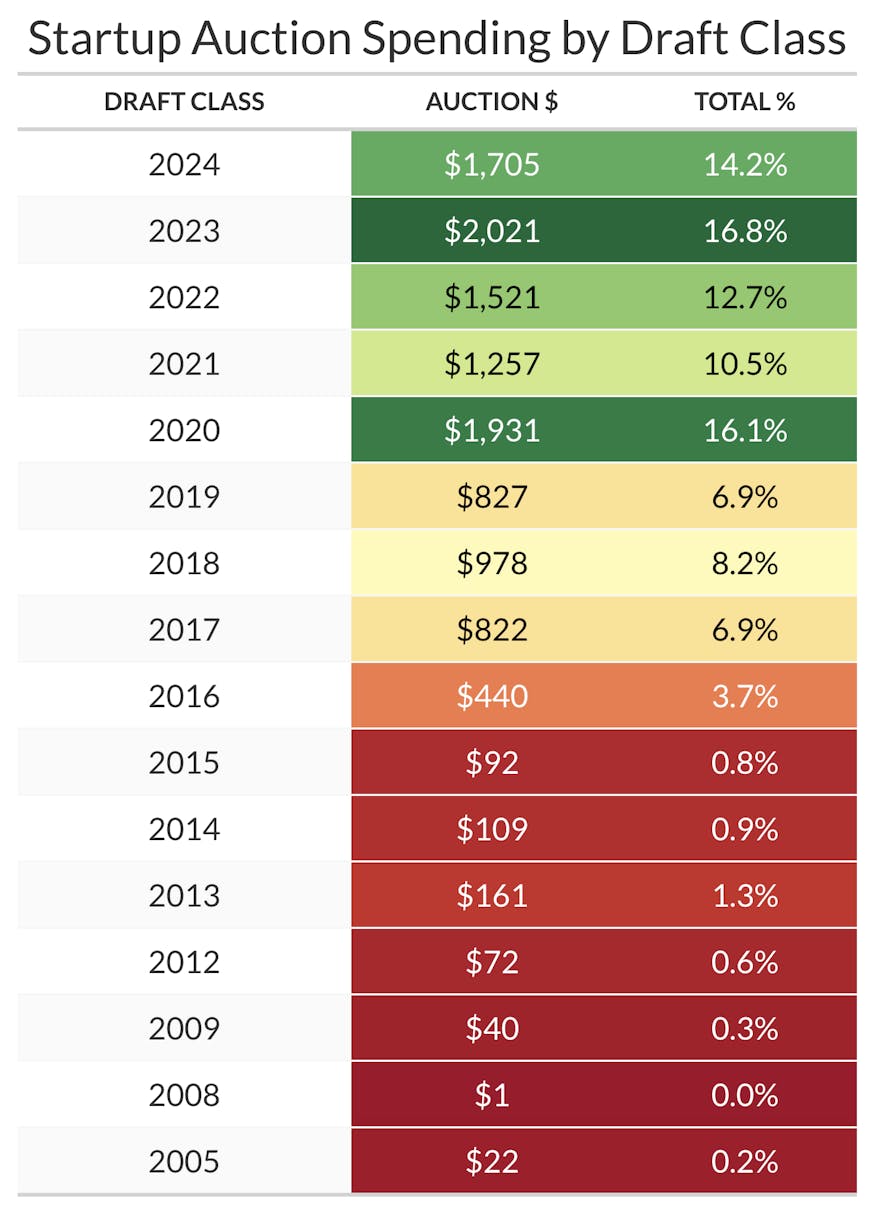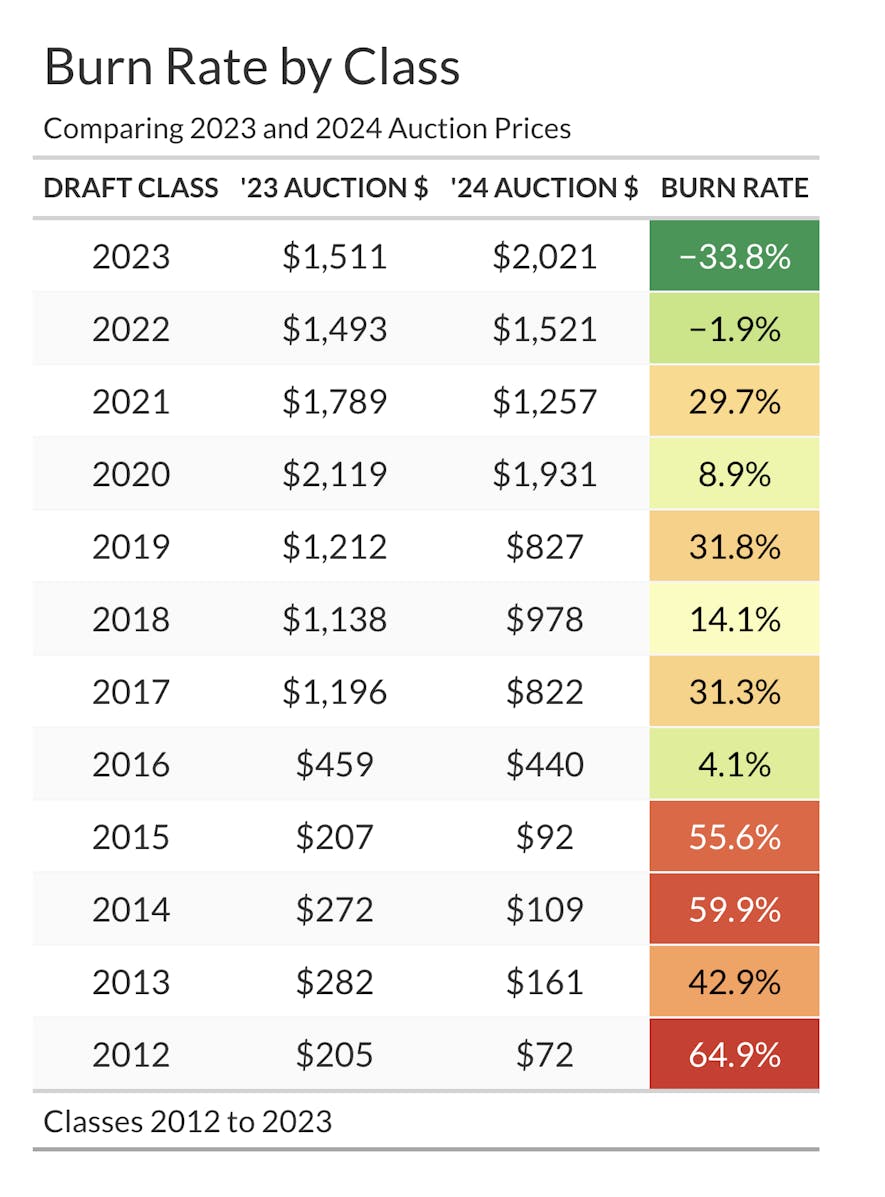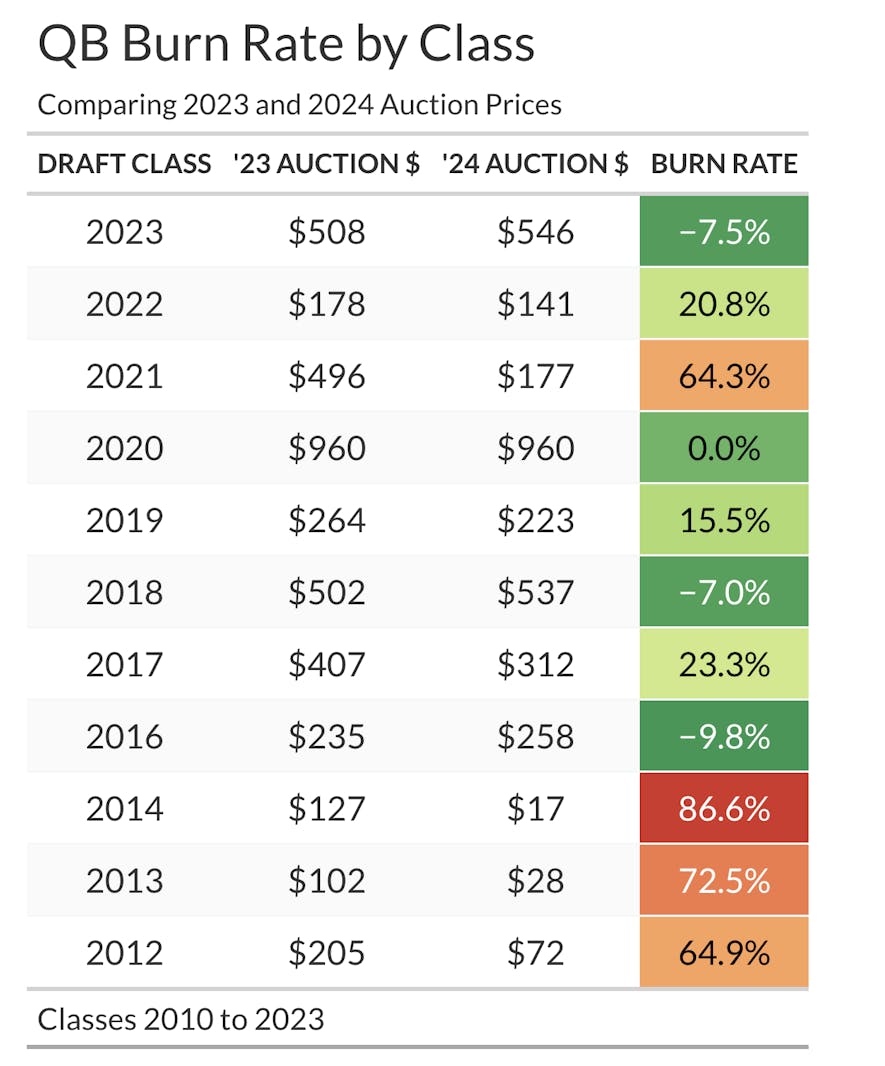In this week's edition of Dynasty Data, we will explore the idea of Burn Rate, which is the amount of value your roster loses (or burns through) from one season to the next.
Last offseason, I sampled actual startups (12-team, Superflex, TE-Premium, with $1,000 Auction Budgets) and calculated Average Auction Values. I did the same for recent Dynasty Startup auctions. Burn rate is easiest to explain if we view dynasty player values through the lens of these Dynasty Startup prices.
Let's start by grouping 2024 Startup Prices by draft class:
We are most interested in a single number from this table -- the startup dollars spent on incoming rookies ($1,705). This is 14.2% of the overall startup dollars, meaning the overall Burn Rate is roughly 14%. In other words, if you did a startup auction in 2023 and put together a perfectly average team, your team would be worth only $860 prior to your 2024 rookie draft. Each team's average rookie draft capital is roughly $140 ($1,705 worth of rookies split between 12 teams).
If the value of your annual draft capital exceeds the value you lose via Burn Rate, your overall dynasty team value will increase. If your Burn Rate exceeds your draft capital, your team will bleed dynasty value.
The key to building a dynasty juggernaut is minimizing your Burn Rate. We know that the Burn Rate overall is 14%. However, that does not mean the expected Burn Rate is the same for all groups of players. Comparing 2023 Startup Auction Prices to 2024 Auction Prices broken down by NFL Draft Class is the best way to understand how the Burn Rate differs depending on the player's age and level of experience. The table below shows the Burn Rate over the past 12 months for each Draft Class:
The calculated burn rates are eye-opening and make the strategy for maximizing your dynasty roster value obvious: Invest in youth!
Let's start with the 2023 rookie class. If you spent $100 of your $1,000 2023 Dynasty Startup budget on rookies and did an average job of picking those rookies, those rookies are worth $133.80 in 2024 Startup Dollars. This is a burn rate of -33.8%. The negative means that instead of burning value, the players actually saw their value increase. Any fantasy value you got from your 2023 rookies last season was "free" production, and on average, those players saw a significant increase in value. Rookie value gains from players like C.J. Stroud, Puka Nacua, Sam LaPorta, De'Von Achane, Dalton Kincaid, and Tank Dell far outweighed the value losses of rookies like Quentin Johnston, Bryce Young, and Michael Mayer. Most owners who invested a big chunk of their startup draft or auction capital into rookies have significantly more valuable rosters today.
On the other end of the spectrum, the dynasty owners who invested a significant chunk of their auction budget on older players (anyone drafted in 2019 or before) saw a massive value drop. The Burn Rate on these older players is scary. If you spent $100 of your 2023 Dynasty Startup budget on players drafted in 2019, those players are only worth $68.20 now. The burn rate of this draft class was 31.8% over the past 12 months.
Burn Rate by Position and Class
We can go deeper. While the table above shows the burn rate by draft class, it is a fantastic starting point. We can gain a much stronger understanding of expected burn rates moving forward by breaking things down by position. In the positional breakdowns below, we will talk about the top strategies to minimize burn rate.
Quarterback
Unsurprisingly, the burn rate numbers at quarterback are much different than those of other positions.
Now that we have things broken down by both draft class and position, we need to be aware of drawing too strong of conclusions from small sample sizes. That being said, here is what stands out about the table above:
- Investing in 2023 rookies at the quarterback position was a smart move, though the average value gain at quarterback was much lower than it was at every other position.
- It was a rough year for the 2021 quarterback class. Justin Fields and Mac Jones were the main causes of the group's value plummeting, but Trevor Lawrence and Trey Lance also saw drops. The class of 2022 did not fare well either. The big takeaway here is that investing in quarterbacks in their first few years is a losing prospect overall.
- 2023 was an especially brutal year to invest in quarterbacks in their early 30s. Russell Wilson, Geno Smith, Derek Carr, and Jimmy Garoppolo saw their values tumble. Small sample size caveats apply, but we should be wary of investing auction or startup draft capital into older quarterbacks.
So, if investing in very young quarterbacks and older quarterbacks were both losing propositions on average, what is the strategy at quarterback?
If we lump all quarterbacks who entered the league between 2016 and 2020 into one group, it becomes obvious this is the sweet spot at the position. We are going to have a few massive value hits for quarterbacks hitting year four to year eight. These quarterbacks in their mid-20s are generally established enough that if we value them highly in dynasty, they are not likely to lose their jobs or see their value get crushed. Think Joe Burrow, Justin Herbert, Josh Allen, Jalen Hurts, Patrick Mahomes II, Tua Tagovailoa, etc. These quarterbacks are also young enough that their value does not see any meaningful decline from one year to the next. This is a sneaky path to "free" production. You get starter-level fantasy production with an extremely low burn rate from these elite mid-career quarterbacks.
Continue reading this content with a ELITE subscription.
An ELITE subscription is required to access content for Dynasty leagues. If this league is not a Dynasty league, you can edit your leagues here.



